With one game remaining in the preseason, the Vancouver Canucks have some serious roster decisions ahead of them.
Opening-night rosters must be submitted by October 7 at 2:00 p.m. PT, so the Canucks will need to figure out their 23 (or less) man roster by that time. Their latest cut of 13 players got them close to their opening-night roster but they’ll still have at least one more cut to make.
It’s not as simple as picking the 23 best players and putting together a roster. The Canucks not only have to be under the roster limit by the deadline but also have to be cap compliant.
Getting under the salary cap won’t be difficult for the Canucks; getting under the salary cap without using long-term injured reserve (LTIR) will be.
Why does avoiding LTIR matter?
When a team uses the cap relief from LTIR, they are considered to be right up against the salary cap, with no real cap space. That means they cannot accrue cap space over the course of the season, limiting their ability to add a player mid-season, such as at the trade deadline.
While the public typically looks at a team’s salary cap over an entire season, cap space is calculated on a daily basis. Every day that a team is under the salary cap, they add to their total cap space for the season.
In practice, this means that a team with, for example, $1 million in cap space to start the season can add a player with a $2 million cap hit halfway through the season. This is because the $2 million player’s cap hit on a day-to-day basis will only add up to $1 million over the back half of the season.
Accruing cap space gets a lot more complicated than that simplified example, as a team’s cap space can change daily. Teams can even maximize the amount that they are under the salary cap by sending players exempt from waivers down to the AHL for days at a time, accruing additional cap space each day.
The Canucks have not been able to take advantage of accruing cap space for several years, as they have consistently been in LTIR right from the start of the season until the end of the season. Tucker Poolman, whose career has essentially been ended by debilitating migraines, has been on LTIR for the past two seasons and will once again be out this season.
This offseason, however, the Canucks took special care to ensure they had room under the cap for Poolman’s $2.5 million cap hit so that they wouldn’t have to put him on LTIR to start the season.
Unfortunately, things got more complicated for the Canucks heading into training camp.
The Canucks’ current cap situation
The Canucks currently have 28 players on their roster, including Poolman. Four of those players could start the season on the team’s Injured Reserve: Poolman, Dakota Joshua, Thatcher Demko, and Akito Hirose.
Pius Suter is currently day-to-day but will presumably be ready to start the season in a week’s time. If not, that will further complicate the Canucks’ salary cap picture.
Here’s what that 28-man roster looks like including each player’s cap hit:
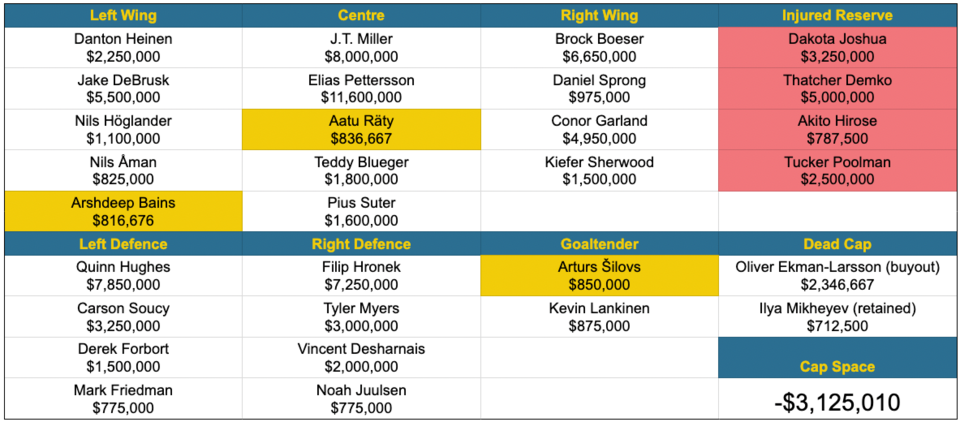
The players marked with red are currently unavailable to the Canucks. Those marked in gold are exempt from waivers and can be sent down to the AHL without risking another team claiming them.
Including the dead cap of Oliver Ekman-Larsson’s buyout and the retained salary from the Ilya Mikheyev trade, the Canucks are currently $3,125,010 over the salary cap.
Notably, that’s with 24 active players — one more than the limit. The Canucks will have to send down one more player to meet the 23-man roster limit.
If we’re looking simply at merit, the final cut could come down to Nils Åman, Arshdeep Bains, and Aatu Räty, with some consideration for Mark Friedman and Noah Juulsen on defence. The easiest player to cut would be Bains, who is exempt from waivers and doesn’t play centre like Räty.
If Bains is sent down, that still leaves the Canucks $2,308,334 over the salary cap.
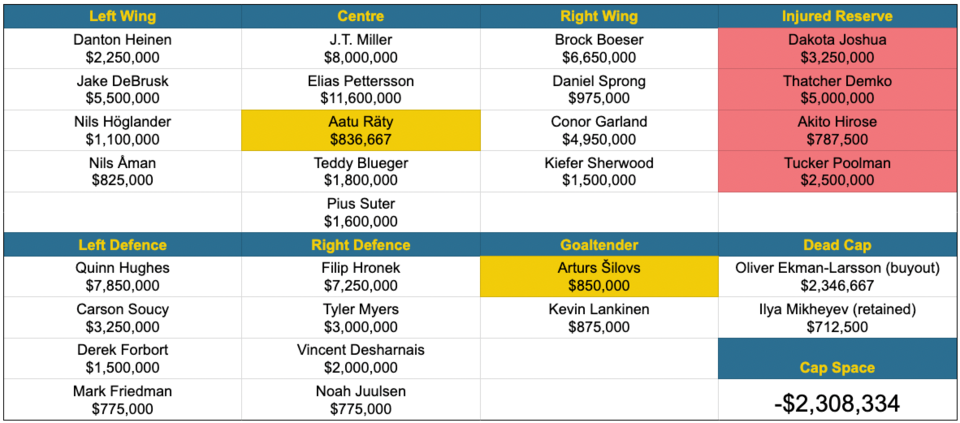
So, what next? What can the Canucks do to get cap compliant?
Taking the easy way out with LTIR
The Canucks could very easily be cap compliant simply by moving Poolman to LTIR and taking advantage of the cap relief.
It’s simple and clean, requiring no extra thought, and it still leaves the Canucks with a 23-man roster, ready to deal with any further bumps and bruises that the regular season throws at them.
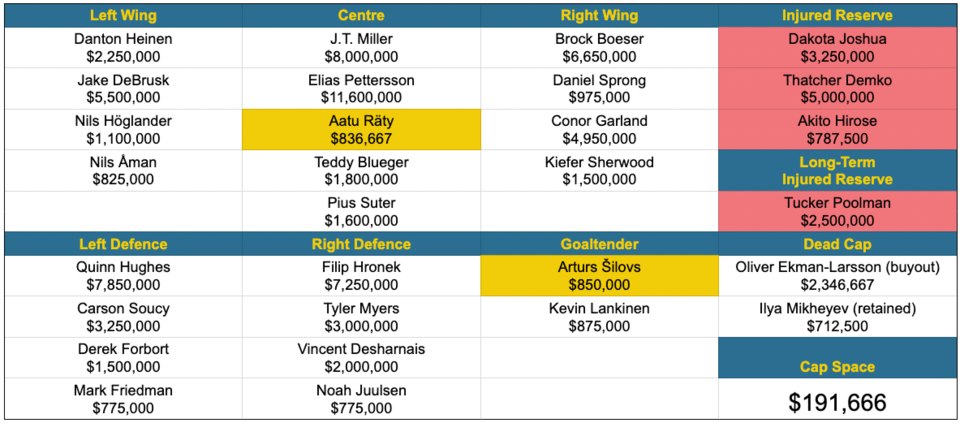
Putting Poolman and his $2.5 million cap hit on LTIR gets the Canucks cap compliant by $191,666.
The issue with this approach, of course, is that the Canucks won’t be able to accrue cap space. So, while it works, it’s not ideal.
The Canucks could ice an undermanned roster
Here’s where things get tricky.
The 23-man roster limit is just what it sounds like: a limit. A team isn’t required to have 23 players on the active roster. The minimum is 20 players: 18 skaters and two goaltenders.
The Canucks could, in theory, put Nils Åman and Mark Friedman on waivers, trusting that they wouldn’t get claimed as teams put together their final rosters. That would leave the Canucks with a 21-man roster that still isn’t cap-compliant.
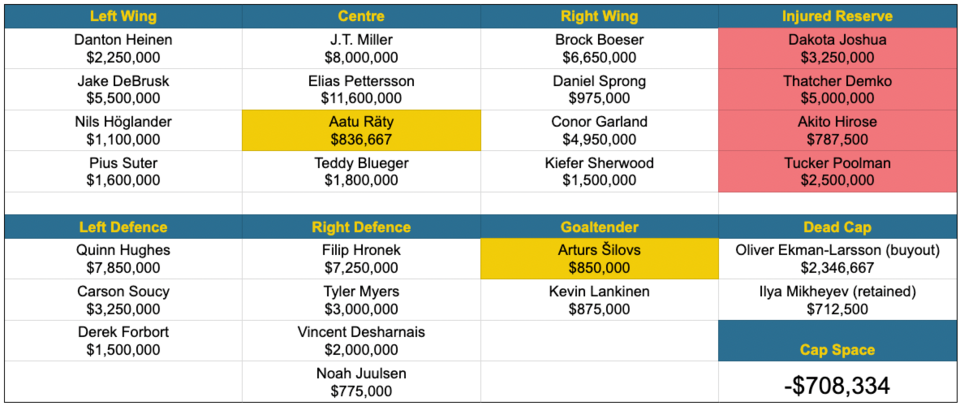
This roster is still $708,334 over the cap but there’s a solution in sight. All the Canucks would need to do is send down one more player with a cap hit over $708,334 and they would be cap compliant without using LTIR.
There are three options:
1 | Send down Räty despite all the work he’s done to make the team in the regular season, leaving the team with just 11 forwards.
2 | Waive Noah Juulsen and hope he doesn’t get claimed.
3 | Hope that Akito Hirose is healthy in time to send him down.
Regarding the first option, the Canucks started last season with just 11 forwards, so it’s not without precedent. Since the minimum roster requires 18 skaters rather than a set number of forwards and defencemen, the Canucks would meet the requirement and Juulsen would presumably dress as a fourth-line forward.
The second option is less than ideal not only because Juulsen could very easily get claimed but also because it would leave the Canucks at risk of playing with just five defenceman if a player got injured on a game day.
As for the final option, it depends entirely on Hirose’s health.
Why the Canucks might not be able to send down Akito Hirose
Hirose suffered an injury in the preseason on a hit by Adam Klapka of the Calgary Flames that sent him back first into the boards, with his head whiplashing back. The defenceman has gone into the NHL’s concussion protocol, with no word on a potential timeline for his return.
Because Hirose was injured while on the Canucks’ NHL roster, he has to stay on the NHL roster until medically cleared. That also means his cap hit will count against the Canucks’ salary cap during that time.
Something similar happened last season with Guillaume Brisebois, who suffered an injury in the final game of the preseason and subsequently was on the Canucks’ NHL roster for almost the entire season while dealing with suspected post-concussion syndrome.
If it seems unfair that a player who wasn’t going to make the team counts against the salary cap simply because he got injured, there is a provision for exactly that scenario: season-opening injured reserve (SOIR). A player on a two-way contract who played fewer than 50 games in the previous season has a reduced or entirely eliminated cap hit while on SOIR.
The first year of Brisebois’s two-year contract was a two-way deal. Since he played just 17 games during the 2022-23 season, his cap hit was significantly discounted while he was on injured reserve with the Canucks last season.
Unfortunately, SOIR does not apply for Hirose, as he is on a one-way contract. His full cap hit will remain on the books as long as he’s on the injured reserve list.
If Hirose hadn’t gotten injured, the Canucks could be cap-compliant with a 21-man active roster without going into LTIR.
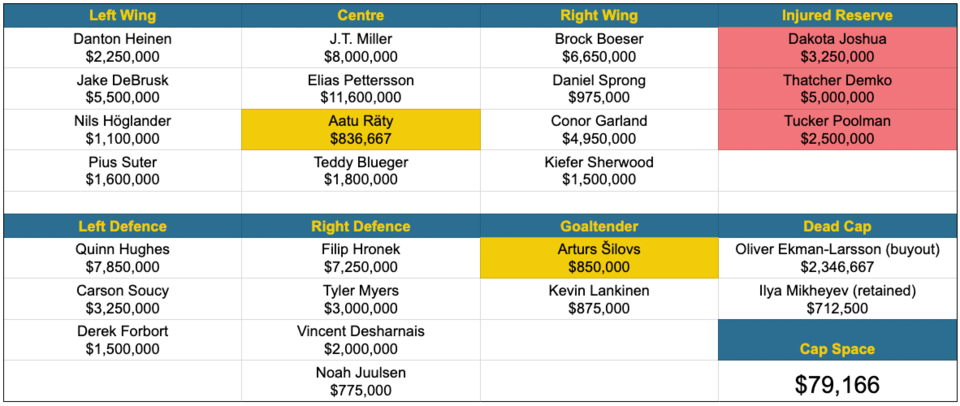
Without Hirose on the IR, the Canucks would be $79,166 under the salary cap with a 21-man roster. They wouldn’t be accruing much cap space, but it adds up over time, so every little bit helps.
What happens when Demko and Joshua return?
For our last little thought experiment, we’ll imagine the ideal world for the Canucks: Thatcher Demko and Dakota Joshua both return, while Hirose clears the concussion protocol and is sent back to the Abbotsford Canucks.
In that scenario, the Canucks would be cap compliant with a 23-man roster, complete with Aatu Räty in the lineup. Nils Åman would be the most likely candidate to get waived and sent down to the AHL.

This roster leaves the Canucks with $154,166 in cap space that can start accruing. The amount of cap space the Canucks accrue could be increased by juggling Räty between the AHL and NHL, though that would hurt Räty’s bottom line, as he would only make his AHL salary on his two-way contract on the days he gets sent down.
This lineup also means that Arturs Silovs would be sent down to the AHL as he is exempt from waivers, leaving Kevin Lankinen as the backup behind Demko.
The upshot of avoiding LTIR at the start of the season is that the Canucks can eventually use it later in the season, such as at the trade deadline. At that point, the Canucks could put Poolman on LTIR and combine that cap relief with their accrued cap space to add an impactful player via trade.
Of course, this ideal scenario requires that the Canucks avoid any more significant injuries as the season progresses in order to maximize the amount of cap space they can accrue.
If the Canucks do have further injuries and/or Hirose is out long-term, it’s going to be very hard for the Canucks to avoid using LTIR.




